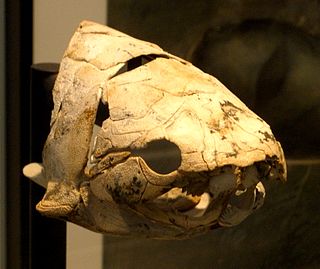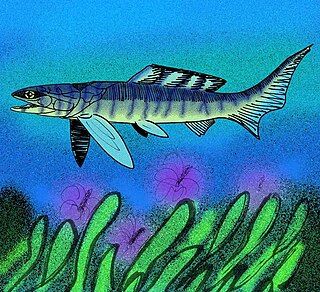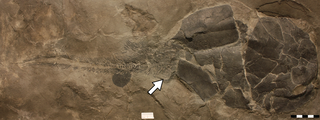
Dicksonosteus is an extinct genus of basal arthrodire placoderm fish which lived during the Early Devonian period of Spitsbergen, Norway.

Eastmanosteus is a fossil genus of dunkleosteid placoderms. It was closely related to the giant Dunkleosteus, but differed from that genus in size, in possessing a distinctive tuberculated bone ornament, a differently shaped nuchal plate and a more zig-zagging course of the sutures of the skull roof.

Fallacosteus is an extinct monospecific genus of arthrodire placoderm from the Early Frasnian stage of the Late Devonian period, found at the Gogo Formation of Kimberley, Western Australia. As with almost all other camuropiscids, F. turneri had an elongated snout that may have enhanced its hydrodynamic streamlining.

Camuropiscis is an extinct genus of arthrodire placoderm from the Early Frasnian stage of the Late Devonian period, found at the Gogo Formation of Kimberley, Western Australia. The species of Camuropiscis had a flattened, elongated snout that may have aided in enhancing its hydrodynamic streamlining.

Latocamurus is an extinct monospecific genus of flat-nosed arthrodire placoderm from the Early Frasnian stage of the Late Devonian period, found at the Gogo Formation of Kimberley, Western Australia.

Gymnotrachelus is an extinct monospecific genus of large selenosteid arthrodire placoderm of the Late Devonian known from the Late Famennian Cleveland Shale of Ohio. The type species Gymnotrachelus hydei was originally reconstructed as physically resembling Selenosteus, with slightly smaller orbits. Later specimens led to a reappraisal, and now G. hydei is thought to have a more gar-like or barracuda-like build.

Xiangshuiosteus wui is an extinct monospecific genus of brachythoracid arthrodire placoderm from the Late Emsian stage of the Early Devonian epoch, discovered in Wuding County of Yunnan province, China. It has recently been reassessed as a dunkleosteid.

Coccosteidae is a family of arthrodire placoderms from the Early to Late Devonian. Fossils appear in various strata in Europe, North America and China.

Kiangyousteus is an extinct monotypic genus of dunkleosteid from the Middle Devonian: Givetian aged Guanwu Formation in the Sichuan province of south-western China. The type species, Kiangyousteus yohii, was the first known arthrodire from Asia.

Harrytoombsia is an extinct genus of arthrodire placoderm from the Early Frasnian stage of the Late Devonian period. Fossils are found from Kimberley, Australia. It was a fast-swimming predator, and it had sharp blades of enamel-like material around the outer edge of the jaw for catching prey.
Golshanichthys is an extinct monospecific genus of dunkleosteid from the Late Devonian: Frasnian stage from Kerman, Iran.
Westralichthys is an extinct monospecific genus of dunkleosteoid from the Late Devonian: Middle Famennian stage from Western Australia. It is estimated to be 3 meters (9.8 ft) long.
Panxiosteus is an extinct monospecific genus of placoderm arthrodire from the Middle Devonian: Givetian stage of Yunnan province, China.
Janiosteus is an extinct monospecific genus of placoderm arthrodire from the Middle Devonian: Late Givetian stage found in Timan, Russia.

Millerosteus is an extinct genus of coccosteid arthrodire placoderm from the Early Givetian stage of the Middle Devonian period. Fossils are found in the Orkneys and Caithness, Scotland. It was a small placoderm with an body length of 14 cm (5.5 in). Millerosteus is one of the few arthrodires known from specimens preserving the entire skeleton.
Dickosteus is an extinct genus of coccosteid arthrodire placoderm from the Late Eifelian to Early Givetian stages of the Middle Devonian period. Fossils are found in the Orkneys and Caithness, Scotland. It was a small placoderm with a total body length of 43.7 cm (17.2 in). It is one of the few placoderms for which complete bodies are known.

Watsonosteus is an extinct genus of coccosteid arthrodire placoderm from the Late Givetian stage of the Middle Devonian period. Fossils are found in the Orkney Islands, Scotland. It was a small placoderm with a total body length of 57 cm (22 in), with the largest individuals reaching lengths of 1 m (39 in). It is one of the few arthrodires for which complete body fossils are known.
Torosteus is an extinct genus of arthrodire placoderm from the Early Frasnian stage of the Late Devonian period. Fossils are found in the Kimberley region of Australia.
Bullerichthys is an extinct monospecific genus of arthrodire placoderm from the Early Frasnian stage of the Late Devonian period. Fossils are found in the Gogo Formation of the Kimberley region of Australia. It was thought to be durophagous, meaning that it preyed upon hard-shelled creatures such as mollusks.
Kendrickichthys is an extinct monospecific genus of arthrodire placoderm from the Early Frasnian stage of the Late Devonian period. Fossils are found in the Gogo Formation of the Kimberley region of Australia. It was thought to be durophagous, meaning that it preyed upon hard-shelled creatures such as mollusks.




















